OPHELIE
Arthur Rimbaud
Sur l'onde calme et noire
où dorment les étoiles
La
blanche Ophélia flotte comme un grand lys,
Flotte très
lentement, couchée en ses longs voiles...
- On entend
dans les bois lointains des hallalis.
Voici plus de
mille ans que la triste Ophélie
Passe, fantôme
blanc, sur le long fleuve noir.
Voici plus de
mille ans que sa douce folie
Murmure
sa romance à la brise du soir.
Le
vent baise ses seins et déploie en corolle
Ses
grands voiles bercés mollement par les eaux;
Les
saules frissonnants pleurent sur son épaule,
Sur son grand
front rêveur s'inclinent les roseaux.
Les nénuphars
froissés soupirent autour d'elle;
Elle
éveille parfois, dans un aune qui dort,
Quelque
nid, d'où s'échappe un petit frisson d'aile:
- Un
chant mystérieux tombe des astres d'or.
II
Ô
pâle Ophélia ! belle comme la neige !
Oui
tu mourus, enfant, par un fleuve emporté !
-
C'est que les vents tombant des grands monts de Norwège
T'avaient
parlé tout bas de l'âpre liberté;
C'est
qu'un souffle, tordant ta grande chevelure,
A ton esprit
rêveur portait d'étranges bruits;
Que ton coeur écoutait le
chant de la Nature
Dans les plaintes de
l'arbre et les soupirs des nuits;
C'est que la
voix des mers folles, immense râle,
Brisait ton
sein d'enfant, trop humain et trop doux;
C'est
qu'un matin d'avril, un beau cavalier pâle,
Un
pauvre fou, s'assit muet à tes genoux !
Ciel
! Amour ! Liberté ! Quel rêve, ô pauvre Folle !
Tu
te fondais à lui comme une neige au feu:
Tes
grandes visions étranglaient ta parole
- Et
l'Infini terrible effara ton oeil bleu !
III
- Et
le Poète dit qu'aux rayons des étoiles
Tu viens chercher, la
nuit, les fleurs que tu cueillis;
Et qu'il a vu sur l'eau,
couchée en ses longs voiles,
La
blanche Ophélia flotter, comme un grand lys.









